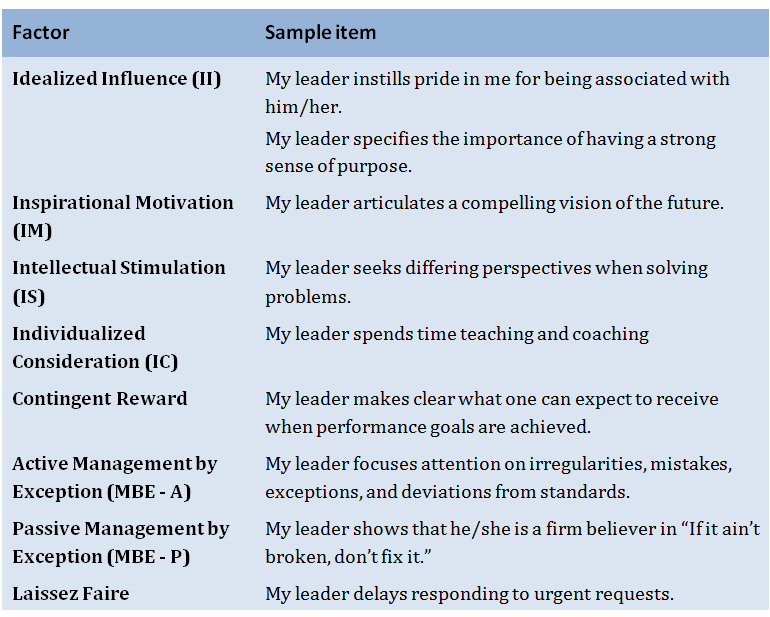Research Paper: Transformational Leadership Model In Coaching
Bass also suggests that highly effective leaders consistently exhibit behaviors related to all aspects of Transformational. “The leader with an optimal profile infrequently displays Laissez-Faire (LF) Leadership. This individual displays successively higher frequencies of the Transactional Leadership styles of MBE – P, MBE – A, CR, and the Transformational components most frequently. In contrast, the poorly performing leader tends towards inactivity and ineffectiveness.” These leaders also use some aspects of Transactional leadership like Contingent Rewards (CR) and Active Management by Exception (MBE – A) to reinforce their Transformational Leadership styles.
Bass and Riggio in their book Transformational Leadership suggest Contingent Rewards is effective under most circumstances. While Active Management by Exception, corrective leadership for failure of a follower to comply, is effective when used together with Transformational Leadership. They also suggest that Contingent Rewards that are psychological such as praise and acknowledgement can be transformational.
In the same book, they present their findings on the effectiveness of Transformational Leadership based on the Multifactor Leadership Questionnaire (MLQ) as follow:
Table 2: Relationship of MLQ Scales with Effectiveness
Transformational Leadership positively affects performance, regardless of whether performance is conceptualized as what others in the unit or organization (i.e. subordinates, superiors) perceive as performance or whether performance relates to more objective, bottom-line sorts of variable.
Multifactor Leadership Questionnaire (MLQ)
Avolio and Bass has developed and perfected Multifactor Leadership Questionnaire (MLQ), the most widely accepted instrument to measure Transformational Leadership. The instrument assesses the Full Range Leadership (FRL). They claims the MLQ is the best researched measure of Leadership and that it shows strong validity, reliability and evidence of prediction of organizational effectiveness.
There are alternatives to MLS assessments including Transformational Leadership Behavior Inventory (TLI), Leadership Assessment Inventory (LAI), Transformational Leadership Questionnaire (TLQ), and Global Transformational Leadership scale (GTL).
In addition to MLQ, there are other measures of Transformational Leadership including diary/journal keeping, executive/leader interviews, and other observational methods, with not much evidence on assessing Transformational Leadership using systematic objective, third-party observations.
Table 3: Sample items from the MLQ
Benefits of using MLQ
MLQ allows the stakeholders to objectively assess the client. As a 360-feedback tool, it allows for information from various raters: peers, supervisors, subordinates or even internal/external customers. It helps create awareness for the client so he/she gets different perspectives on his/her own behaviors and how others perceive him/her as a leader. MLQ itself focuses on key leadership behaviors required to be effective so the raters can objectively rate the client based on the Full Range Leadership Model. As a standard assessment tool, MLQ is readily available at a reasonable price so it’s financially viable and does not required time or resources to develop when compare to a custom assessment tool.
Coaching Application
Leadership Coaching focuses on assisting leaders with sustainable positive change required to be effective. The coaching focuses on ensuring the leaders consistently exhibit leadership behaviors required to be effective in their roles whether they are front-line supervisors or executives.
Transformational Leadership model can be used as a framework for leadership coaching. By using the Multifactor Leadership Questionnaire (MLQ) and other data collection methods to help the client understand his/her strengths and areas of improvement, identify key behavioral changes required by involving key stakeholders and use this information as the basis for creating awareness and actions.
Coaching process
The coaching process consists of four steps: Process Preparation, Stakeholder Identification, Client Assessment, and Client Development with Stakeholder Involvement as a critical success factor.
Process Preparation
Preparation is an initial meeting with the client. It involves getting alignment between the coach and the client on client’s expectations and desired outcomes, the level of motivation to change and the commitment level to the coaching process. The coach also takes the opportunity to get clarification and uncover any hidden objections that the client might have.
Questions includes:
Stakeholder Identification
The second step in the process is to identify key stakeholders. Key stakeholders are those who should get involved in the client’s coaching process from assessing client’s behaviors, identifying the key behaviors for the client to focus on and providing support and feedback during his/her development. They will also confirm the change/results at the end of the coaching engagement.
The key behaviors are those few behaviors selected from the assessment results that will yield positive change the client and his/her stakeholders agree will make the most impact and increase his/her leadership effectiveness.
Once selected, the key stakeholders are then oriented to the coaching process and their role and responsibilities during the process.

